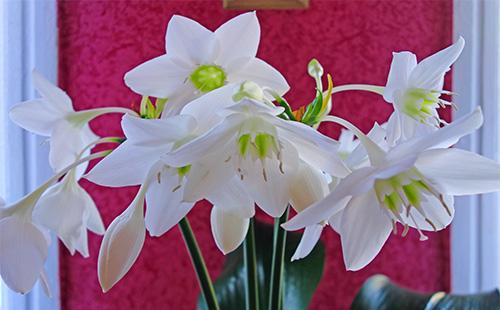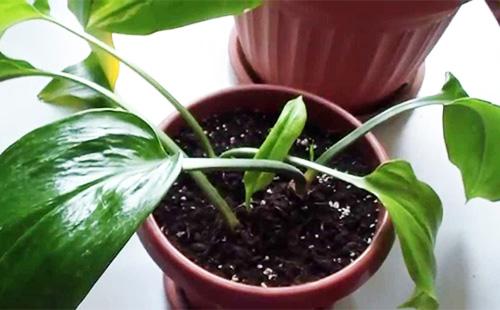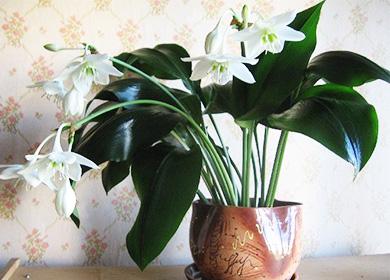The content of the article
Many exotic novelties brought centuries ago from distant colonies have firmly entrenched with our home windowsills. The native habitats of eucharis are the tropics of Central and South America, Colombia, the Eastern Andes, and the western Amazonia. Either with the geographical affiliation, or with a picturesque comparison with the Amazonian beauties, the second name of the flower is “Amazonian Lily”. In fact, with its structure, eucharis is more like a giant daffodil.
From an astrological point of view, eucharis is a Sagittarius plant, a talisman for success in spiritual development and travel.
The appearance of the Amazon
Eucharis is an evergreen perennial from the Amaryllis family, which propagates by dividing the bulbs. The Greek name of the plant is translated as "graceful", "full of grace", which exactly corresponds to the appearance of the tropical "dudes".
- Rhizome. A large spherical onion in golden chocolate flakes, from 4 to 6 cm in diameter. In appearance and color is very similar to an ordinary onion.
- Leaves. Dark green, like varnished leaves of eucharis grow from the bulb itself. Their traditional number is from two to seven. The maximum length is 60 cm, width is 15-20 cm. Foliage occupies a large area, therefore free space is an important condition for placing eucharis.
- Flower stalk. Leafless, slender peduncle grows from the center of the bulb. Has a height of up to 80 cm.
- Inflorescence umbrella. Decorates the top of the peduncle and consists of three to ten buds. Large snow-white flowers formed by six two-tiered petals bloom alternately and live one and a half weeks. Depending on the variety of plants, are blue or cream.
- Fetus. After flowering eucharis, a fruit is tied. It is a green, three-chamber box with seeds.
Tropical Plant Varieties
In home floriculture, a dozen species of indoor eucharis are known. The following four varieties that do not have radical external differences are the most popular and unpretentious.
- Eucharis is large-flowered. The most common variety among gardeners. Flowering time - the last months of spring and summer, the beginning of winter. It has large bulbs, oblong leaves of a dark green color, umbrella white flowers with an intense aroma.
- Eucharis is white. It blooms in March.It can be identified by an egg-shaped bulb, wide, oval leaves, lush creamy white flowers.
- Eucharis Sandera. A large plant with oblong bulbs and oval dark green spreading leaves blooms in February with either several large flowers or small buds. Petals are snowy white.
- Eucharis Masters. It has massive, broadly oval leaves, on the peduncles there are two umbrellas of pleasantly smelling flowers. The flowering time of this species of eucharis is March.
Features of care for eucharis
Due to its unpretentiousness and endurance, eucharis very quickly adapts to room conditions. Subject to a number of requirements, the plant will delight with abundant and spectacular flowering.
Necessary lighting
Amazonian Lily is a photophilous culture. A pot of decorative exotica is placed on the southwest or southeast side. In summer, in the afternoon sun, the windows are shaded to prevent leaf burns. Eucharis will develop normally and bloom even on the north side. However, if there is a choice between bright lighting and shadow, choose the first.
Temperature mode
During the period of growth and flowering of thermophilic eucharis, it is customary to consider room temperature from + 18 ° C to + 22 ° C optimal. In winter, it is important to keep the plant at + 15-17 ° C. Lily should be protected from daily temperature jumps, drafts, cool nights on the balcony and the first autumn frosts are harmful to her.
Tropical humidity
Tropical eucharis is used to high humidity (at least 60%). The right microclimate will be created by regular spraying. This procedure is also relevant in winter, when the air is overheated by heating devices. A warm shower and wet wiping of sheet plates are also suitable. Stop irrigating the plant during flowering. Drops of water on the buds and flowers will make them brown.
Watering
Indoor eucharis requires moderate watering. Moisturize the soil when it dries to 1/3 of the height of the pot. The drying level of the soil mixture should be constantly monitored to prevent the bulb from drying out. An excess of moisture is even more destructive: it will start putrefactive processes in the rhizome of eucharis. The soil is intensively watered only during flowering; during the dormant period, watering is completely excluded.
Soil components
When choosing soil, you need to consider that the plant does not tolerate waterlogging. The mixture should be nutritious and moisture-consuming. This composition is recommended (in a quantitative ratio of 2: 1: 1: 1):
- leaf soil;
- turf land;
- peat;
- coarse sand.
Sand can replace charcoal or store soil for cacti. An indispensable condition is drainage from pebbles, gravel, brick fragments. It is possible to grow eucharis in hydroponics.

Top dressing
Amazonian lily is responsive to soil fertilizer, which is required to be applied a couple of times a month and only during the period of growth and flowering. Like most amaryllis, eucharis prefers mineral concentrates. Use a dosage lower than recommended by the manufacturer. Organic fertilizers with their inherent high levels of nitrogen can damage the bulbs. But Amazonian lily reacts normally to feeding manure with cow dung. Feed the plant stop immediately after flowering eucharis.
Transplantation
A transplant of indoor eucharis is rare: once every three to four years. The procedure is carried out during the rest period, it requires accuracy and preservation of the integrity of the earth coma. The bottom of the pot for a couple of centimeters is filled with drainage material, the lump with the bulb is lowered to a maximum depth of 5 cm, the voids are covered with fresh soil. An eucharis transplant does not involve disconnecting the “children” from the maternal rhizome.
Why does not bloom
According to reviews of owners of tropical lilies, problems with its bloom are not isolated and are the result of violations in the process of caring for the plant. It:
- wrong choice of flower pot size;
- not characteristic of the flower arrangement;
- bulb age too young;
- violation of temperature conditions, a sharp change in temperature;
- expenditure of energy to fight diseases or pests;
- rotting of the bulbs, which can be detected by pulling the flower out of the pot.
Rest during rest
How to care for eucharis, after flowering of which the rest period begins?
What is characteristic for this stage of life of an ornamental plant? Here are the highlights:
- training - eucharis is sent for a well-deserved rest after the removal of wilted peduncles;
- duration - a month and a half, the flower gains strength and energy for future growth;
- seasonality - usually this happens between April and October;
- regularity - how many times a year eucharis will bloom, a similar number of times a plant needs to organize a dormant period;
- microclimate - cooler conditions are possible, but not required;
- watering - temporarily stops and resumes gradually with the advent of young shoots.

Possible problems
Growing eucharis (Amazonian lily) at home can be accompanied by the appearance of pests, diseases. Immediately suffer the decorative properties of a room flower. True, such troubles happen only with weakened plants that were damaged as a result of improper maintenance. What symptoms report health problems?
- In eucharis, the leaves turn yellow and die. The reason is a sharp change in conditions of detention. Single falling of yellow leaves is the norm. With a massive "leaf fall" it's time to sound the alarm and eliminate the mistakes of leaving.
- Leaves fade. This can occur during hypothermia of eucharis or as a result of watering the soil with too cool water.
- Leaves dry, covered with bright spots. The reason is an excess of light, a sunburn.
- The border of leaves dries. If this occurs in winter, then the plant is in contact with a cold window.
- A white coating appears. This symptom indicates the appearance of one of the most harmful insects on the eucharis - the mealybug. An infected plant suffers from a nutrient deficiency that withers. Damaged by the parasite leaves - curl. Treatment consists in treating the diseased flower with insecticides.
- Red spots are visible on the leaves, onion. Appear with stagonosporosis - a fungal disease of bulbous plants. Fungicides containing copper can cope with a red burn. Affected areas are removed and cut sites are treated.
- There are brown spots on the foliage. If further spots like a chameleon change color to ashen, olive gray and brown, then eucharis was struck by gray rot. There is a fluffy coating, similar to powdery mildew. Buds and flowers darken, fade and fall. At the first signs of disease, the plant is isolated and treated with fungicidal drugs.
- Leaves lose color, dry out. A possible cause is a thrips attack. The foliage of eucharis acquires a characteristic lead shade, becomes covered with whitish spots. Sick leaves are cut off, and the plant is treated with a special antiseptic solution.
Breeding technique
Most often, the plant is propagated by bulbs, "children", much less often - by seeds. The second method is considered to be long and exhausting for both participants in this process: both for the plant and for its owner. Thus grown lilies bloom only in the fifth year.
Method # 1: daughter bulbs
Eucharis is a “companionable” plant. Consider this if you decide to plant it with "kids." It develops much better in the company of three to five bulbs, planted from each other at a distance of no more than 5 cm, that is, with minimal space for the roots. The daughter bulbs are carefully separated, shallow placed in the prepared soil, watered and left in a place protected from the sun for a week and a half. For the fastest rooting, you can use the lower soil heating to + 22-30 ° C. Remember the poisonousness of the plant and wear protective gloves.

Method # 2: seeded
The seed method has a lot of shortcomings, so it is rarely used. And this is either breeders or experienced growers, since you need to pollinate eucharis yourself. With a successful procedure, the collected seeds are sown in a shallow container with moist soil, covered with a bag and kept in a warm place. The first shoots may appear in 15-20 days.
At home, this method is quite long and ineffective: a young plant may not retain maternal symptoms.
For a fragrant plant, you need to find a suitable place in the apartment. Smells affect people differently: some give mood, others soothe, and still others (the Amazon lily can be attributed to them) give vigor and activity. What is the care for eucharis in a pot - it’s not difficult to assimilate, but for what room to use it, your own feelings will tell. But in the bedroom it is better not to keep a fragrant flower. And for the working area (especially for children) eucharis is just a godsend. According to popular beliefs, he is able to develop attentiveness, perseverance and a craving for knowledge in a child. Being next to a woman, a tropical lily protects her from failures and the evil eye. And if the exotic beauty suddenly begins to dry out, they say that the plant took on the disease of one of the family members.

